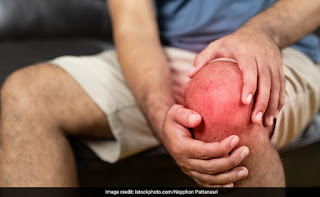● ANKYLOSING SPONDYLITIS:
It is an inflammatory disease causing the fusion of spinal bones. This fusion makes the spine less flexible and results in a henched-forward posture and decreases the flexibility of the vertebrae. Ribs can also be affected which makes breathing difficult.
Symptoms include-
A. Cartilage between breastbone and ribs
B. Vertebrae in the lower back
C. Joint between the base of spine and pelvis
There is no treatment for ankylosing spondylitis full stop treatment is given to lessen the symptoms and lower the progression of disease.
● GOUT:
As explained above, the primary cause of gout disease is the presence of excess of uric acid inthe body. This excess uric acid keeps on accumulating and forms urate crystals.Most common symptoms are :-
A. Intense joint pain, usually the large joint of big toe {pain may last for 4 to 12 hours afterit begins}
B. Inflammation and redness
C. Limited range of motion
● JUVENILE IDIOPATHIC ARTHRITIS:
It is the most common type of arthritis in children under the age of 16. Juvenile idiopathicarthritis can cause serious complications such as growth problems, joint damage, eyeinflammation and treatment is often focused on controlling pain and inflammation, improvingfunction and preventing damage.
Symptoms may include :-
A. Joint pain or limping especially the first thing in the morning or after a nap
B. Joint swelling especially in larger joints such as, knee.
C. Stiffness and clumsiness more than usual particularly in morning or after a nap.D. Fever, swollen lymph nodes and rash on the trunk which is usually worse in the evening.Affected patient can experience symptoms for only few months or for years also.
●OSTEOARTHRITIS:
It is the most common type and affects millions of people worldwide. it happens when theprotective cartilage starts wearing down over time.Most common affected areas are hands, knees, hips and spine.
Symptoms include :-
A. Pain in the affected area during or after movement.
B. Stiffness upon awakening or after in activity
C. Tenderness on applying light pressure on the joint
D. Loss of flexibility
E. Grating sensation and a sound of popping and cracking
F. Swelling might be caused by inflammation of soft tissue around the joint
● PSORIATIC ARTHRITIS:
Psoriatic arthritis fact some people who develop psoriasis - a condition where skin becomes redand is topped with silvery scales. It can affect any part including fingertips and spine.There is no cure for this disease therefore, treatment is focused on controlling symptoms andpreventing damage to the joints.
Symptoms include:-
A. Swollen finger and toes
B. Pain at the points where tendons and ligaments attach to the bones specially back of theheel and sole of the foot.
C. Lower back pain
● RHEUMATOID ARTHRITIS:
Is a chronic inflammatory disorder and can affect more than just the joints. It can affect bonemarrow, salivary glands, kidney, eyes, lungs, heart and blood vessels too. It is an auto-immunedisorder, where the body's immune system mistakenly attacks the body's tissue. It affects thelining of the joints, causing painful swelling which finally results in bone erosion and jointdeformity.
Symptoms may include :-
A. Tender, warm and swollen joints
B. Joint stiffness in the morning or hours of inactivity
C. Fatigue, fever and loss of appetite
● SEPTIC ARTHRITIS:
As the name suggests, it is caused by sepsis, that is, infection in the joint. Infection can happen by the contact of microorganisms through the bloodstream from another part of the body for some penetrating injury at the site of the joint. Treatment includes draining the joint with the help of a needle or surgically followed by a course of antibiotics which is prescribed to treat the infection.
Symptoms include:-
A. Swollen, red and warm joint
B. Extreme discomfort and pain
C. Fever



.jpeg)


